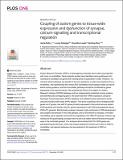| dc.contributor.author | Reilly, Jamie | |
| dc.contributor.author | Gallagher, Louise | |
| dc.contributor.author | Leader, Geraldine | |
| dc.contributor.author | Shen, Sanbing | |
| dc.date.accessioned | 2021-01-06T14:40:08Z | |
| dc.date.available | 2021-01-06T14:40:08Z | |
| dc.date.issued | 2020-12-18 | |
| dc.identifier.citation | Reilly, Jamie, Gallagher, Louise, Leader, Geraldine, & Shen, Sanbing. (2020). Coupling of autism genes to tissue-wide expression and dysfunction of synapse, calcium signalling and transcriptional regulation. PLoS ONE, 15(12). doi:10.1371/journal.pone.0242773 | en_IE |
| dc.identifier.issn | 1932-6203 | |
| dc.identifier.uri | http://hdl.handle.net/10379/16417 | |
| dc.description.abstract | Autism Spectrum Disorder (ASD) is a heterogeneous disorder that is often accompanied with many co-morbidities. Recent genetic studies have identified various pathways from hundreds of candidate risk genes with varying levels of association to ASD. However, it is unknown which pathways are specific to the core symptoms or which are shared by the co-morbidities. We hypothesised that critical ASD candidates should appear widely across different scoring systems, and that comorbidity pathways should be constituted by genes expressed in the relevant tissues. We analysed the Simons Foundation for Autism Research Initiative (SFARI) database and four independently published scoring systems and identified 292 overlapping genes. We examined their mRNA expression using the Genotype-Tissue Expression (GTEx) database and validated protein expression levels using the human protein atlas (HPA) dataset. This led to clustering of the overlapping ASD genes into 2 groups; one with 91 genes primarily expressed in the central nervous system (CNS geneset) and another with 201 genes expressed in both CNS and peripheral tissues (CNS+PT geneset). Bioinformatic analyses showed a high enrichment of CNS development and synaptic transmission in the CNS geneset, and an enrichment of synapse, chromatin remodelling, gene regulation and endocrine signalling in the CNS+PT geneset. Calcium signalling and the glutamatergic synapse were found to be highly interconnected among pathways in the combined geneset. Our analyses demonstrate that 2/3 of ASD genes are expressed beyond the brain, which may impact peripheral function and involve in ASD co-morbidities, and relevant pathways may be explored for the treatment of ASD co-morbidities. | en_IE |
| dc.description.sponsorship | Funding was provided by Science Foundation Ireland (Grant 13/IA/1787 to S.S. and L.G., 16/RC/3948 to FutureNeuro), and National University of Ireland Galway (Grant RSU002 to S.S.) for funding the research. | en_IE |
| dc.format | application/pdf | en_IE |
| dc.language.iso | en | en_IE |
| dc.publisher | Public Library of Science | en_IE |
| dc.relation.ispartof | Plos One | en |
| dc.rights | Attribution-NonCommercial-NoDerivs 3.0 Ireland | |
| dc.rights.uri | https://creativecommons.org/licenses/by-nc-nd/3.0/ie/ | |
| dc.subject | autism genes | en_IE |
| dc.subject | dysfunction of synapse | en_IE |
| dc.subject | calcium signalling | en_IE |
| dc.title | Coupling of autism genes to tissue-wide expression and dysfunction of synapse, calcium signalling and transcriptional regulation. | en_IE |
| dc.type | Article | en_IE |
| dc.date.updated | 2021-01-05T17:15:24Z | |
| dc.identifier.doi | 10.1371/journal.pone.0242773 | |
| dc.local.publishedsource | https://dx.doi.org/10.1371/journal.pone.0242773 | en_IE |
| dc.description.peer-reviewed | peer-reviewed | |
| dc.contributor.funder | Science Foundation Ireland | en_IE |
| dc.contributor.funder | National University of Ireland, Galway | en_IE |
| dc.internal.rssid | 24233013 | |
| dc.local.contact | Geraldine Leader, Dept. Of Psychology, Room 203, St. Anthony'S, Nui Galway. 3434 Email: geraldine.leader@nuigalway.ie | |
| dc.local.copyrightchecked | Yes | |
| dc.local.version | PUBLISHED | |
| dcterms.project | info:eu-repo/grantAgreement/SFI/SFI Investigator Programme/13/IA/1787/IE/Role of NRXN1 in neurodevelopmental disorders: from stem cells to clinical phenotypes/ | en_IE |
| nui.item.downloads | 72 | |


